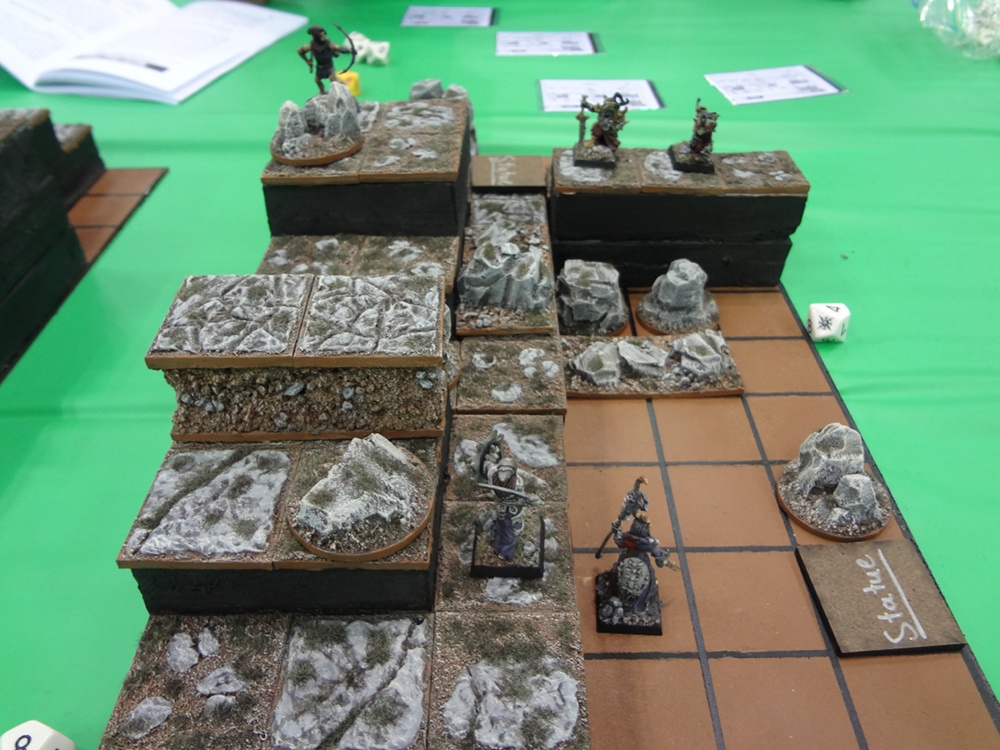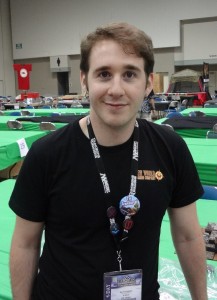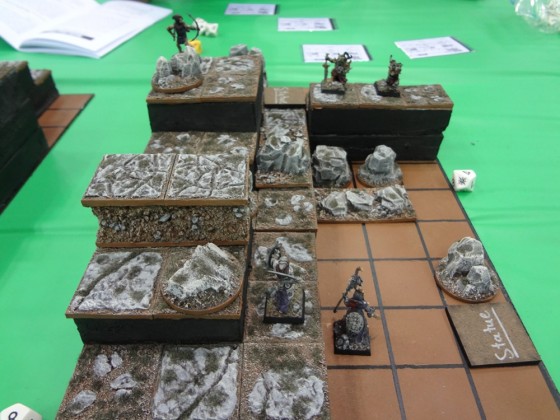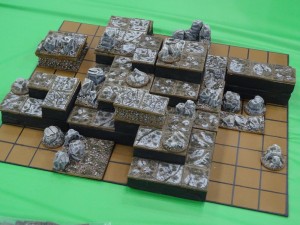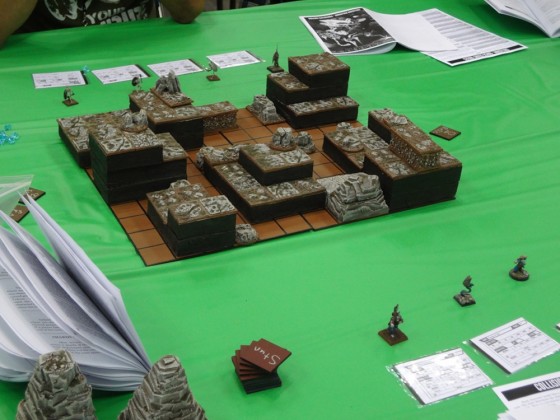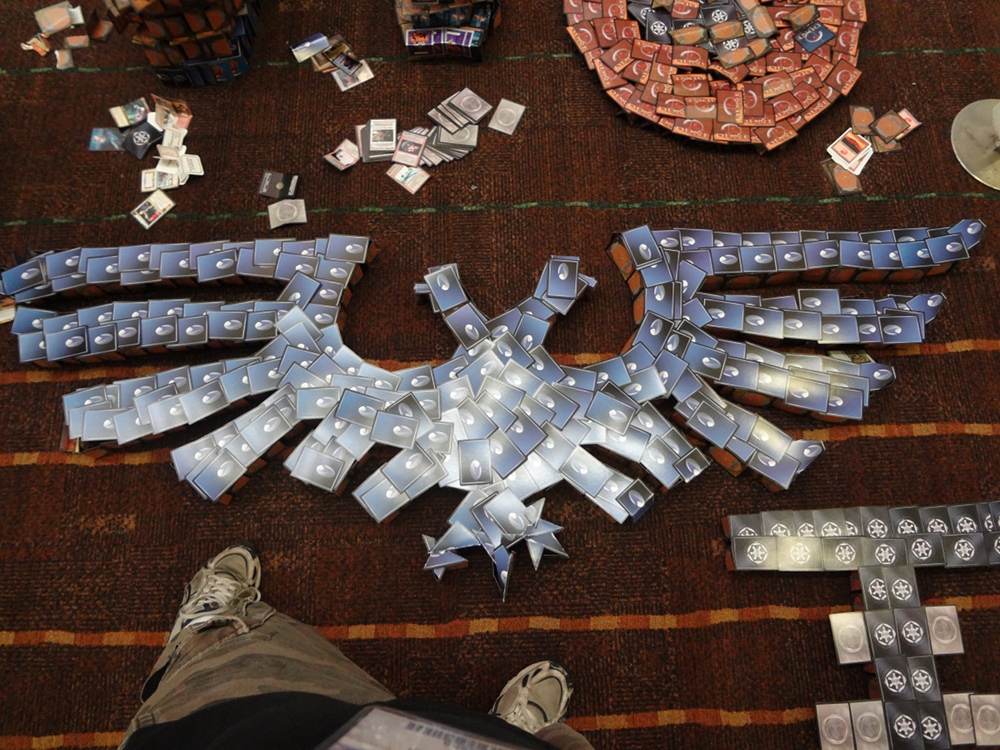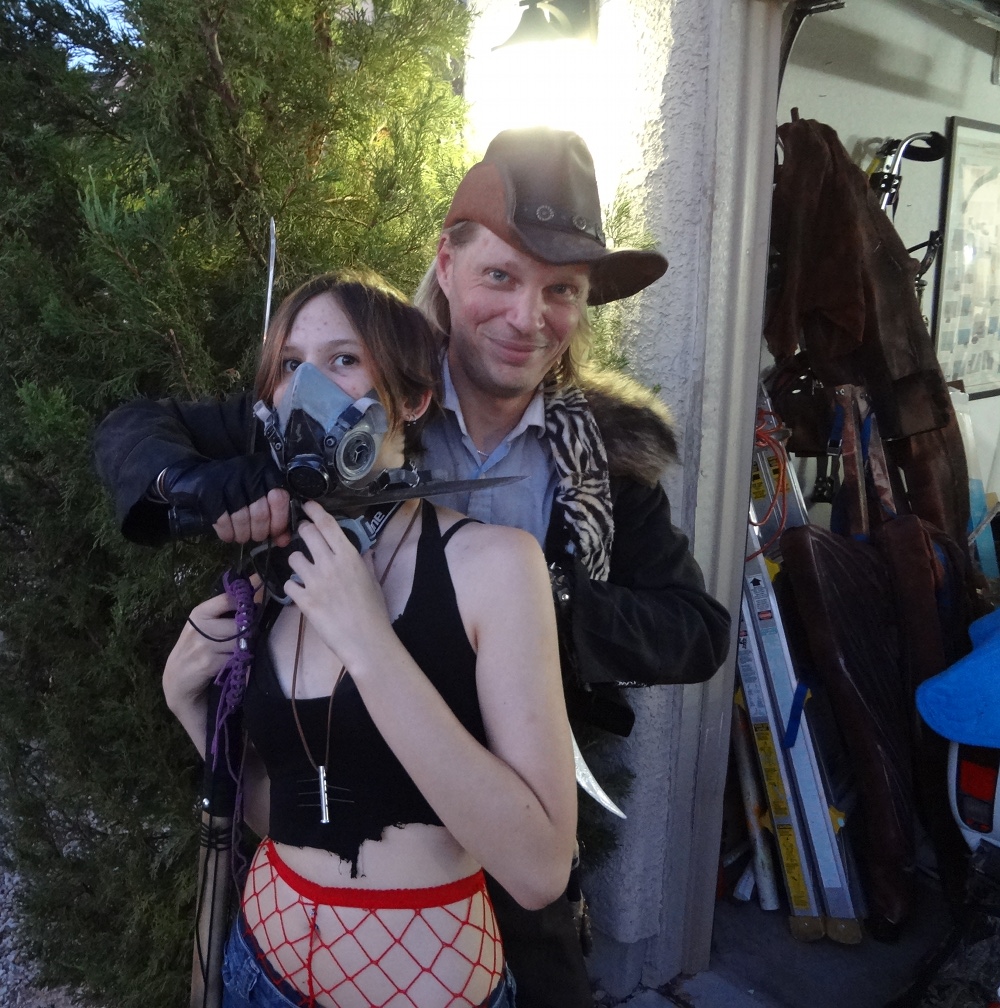On a Collision Course with Ian Douglass
At Gen Con 2012, I took the opportunity to play the miniature skirmish game Collision against its creator, Ian Douglass. Douglass, who heads New World Gaming Company, managed a close victory with a frustratingly-effective archer. We caught up on September 8 about Collision, which is available for free download on Douglass’s site.
Overview of Collision
CG: How long has Collision been in development?
ID: In its current form about three years. It has been kind of a long slog since I have been doing it in my free time.
CG: And by current form you mean as a miniature game and not a D&D setting?
ID: Yes. Collision started out as a D&D setting, and eventually I tried to develop a simplified version of the combat system for larger battles. Through revision it departed more and more from D&D, and after a while I decided that it could be its own game.
CG: So the campaign events at Gen Con? Did those go off? What were they like?
ID: They did go off, and they were a run of a basic campaign in where each battle is tied to the next. However there were fewer battles than I had first planned for because each battle took so long
CG: Who were the players? Had they played Collision before?
ID: Some of the players were friends of mine, some were first-time players, but most had played in one of the intro battles and wanted to play larger battles. I was worried that I wouldn’t actually have enough players to run them, but it turned out to be a great few events.
CG: Yeah, I know from some other game designers, that some of the planned events don’t really happen as intended. Now do you play Collision yourself in this series of campaign games and what sort of things developed for the Gen Con players?
ID: I only participated in a couple of the battles myself. The basic story was that the Necromancer Virgil had suffered a major defeat and was attempting to re-take his captured bodyguard.
CG: And did he?
ID: When I had designed the forces and the scenarios I was worried that Virgil and his forces would be over-powered. The players also felt that the forces were un-balanced, but he was sorely defeated at every turn. Instead of a ride to conquest and re-capture, the campaign turned into the story of Virgil’s death.
CG: Awesome.
ID: I had intended for him to die, but not this soon. He will be coming back though, he’s a Necromancer after all.
The World of Collision
CG: So when we played at Gen Con, I used a Noble Duelist and an Attendant of the 5 Dragons, do these instantly ring a bell with you and you can picture what they look like in the land of Gea automatically?
ID: Yes, the Noble Duelist is a bodyguard of the court of Deadholm, the northern city-state where Virgil is from. The duelist was a red elf and a formidable one at that. The Attendant of the 5 Dragons is a mage from Deadholm who serves Chimeras (essentially dragons), but the 5 oldest Chimeras in particular. The Attendants study magical disciplines that mimic the capabilities of those 5 Chimeras, mainly death, fire, corrosion, frost, and electricity.
CG: Which is why you thought I might have a special power for one of those elements or damage types, I guess.
ID: Yes, that Attendant in particular mastered Corrosive magic.
CG: Going back, what era and edition of D&D did Collision begin as a campaign in?
ID: 3.5 Edition D&D, and my first campaign in Gea as a setting was in 2005.
CG: So a Red Elf, when it was a D&D campaign, are they just regular elves or something a bit different?
ID: For Gea I developed two Elven sub-races: White Elves and Red Elves. Red Elves were more like Wild Elves as far as their stats were concerned, high strength and dexterity. In personality they are impulsive, prone to anger, and make great fighters and soldiers, whereas the White Elves were more frail but magically potent. They are calm and detached and make for powerful wizards or clerics. Naturally they are mortal enemies.
CG: Excellent, I see. And these named characters, Virgil and Rhona, were any of these PCs or NPCs?
ID: Virgil existed as a PC during one campaign years ago, and moved to an NPC role when that particular campaign game to a close. Rhona on the other hand was a PC more recently. Virgil is one of my old characters, whereas Rhona was one of my sister’s characters.
CG: Even better, because I was just about to ask if all of the artwork on your website was Alexandra Douglass’. So she’s your sister?
ID: Yes, though she goes by Lexxy. Apart from the world map which was illustrated by Sarah Williams, all of the art in Collision is drawn by Lexxy at the moment.
CG: How much direction have you given her as to what your world looks like and how much are things that she has come up with?
ID: In this project I have given a lot of direction, providing written description, sketches, tone. Since Lexxy is my sister, her ability to bring my visions to life is unparalleled. There is another project I am developing which I just gave her rough descriptions of monsters and she produced perfect sketches of what I had in mind.
CG: Is she your twin? Who’s older?
ID: She is 4 years older than me, but we grew up with very similar interests. We both grew up with D&D from a young age, so we are both heavily influenced by games. She was inspired to illustrate with the intention of creating art for games, and I was inspired to design games.
CG: As close as the two of you are, what’s it like to share world-building with another person? Is it quite different from being the all-powerful DM?
ID: I never took the DM role with an iron fist. I always liked to involve my players in the creative process, and bouncing ideas back and forth with other people is often how the best things come up.
CG: Gotcha.
Getting Physical with Collision: Mechanics and Crunch
CG: One of the abilities or mechanics that stands out in a unit’s stat card for Collision is the Tarot. What’s the story there?
ID: In its earlier stages, the game had nothing to do with Tarot. In its place characters had a class and a level, but I wanted to separate Collision from D&D more. I dabble in tarot reading, so I came to the realization that there were 4 suits in the minor arcana, and 4 classes in Collision. Plus, the major arcana such as the Tower, and Strength allowed me to create special circumstances for named characters. So in essence a character’s tarot is both who they are and their destiny. However minor arcana characters can change their destinies, but major arcana characters can’t.
CG: What little I know of Tarot comes from the anime series Escaflowne, which features tarot heavily. So for you, since tarot wasn’t initially part of Collision, has it been about digging into your own fluff and really boiling down a character or unit to a tarot card and finding focus there?
ID: Actually the decision to include tarot led to an expansion of fluff rather than a refining of it. As much as a would alter a character to suit a card, I found myself coming up with new ideas because of the tarot. I had to find a place for the characters I already had, but there was so much room. For example who is Death? who is the Devil? who is the Sun? These are all questions I now have to answer, and it will help me grow the game and the content.
CG: Well, what are Virgil and Rhona’s Tarot?
ID: Virgil is the Tower. The short story “The Fall of Virgil” illustrates that Virgil is a character defined by tragedy. Rhona is Strength, and it isn’t just because she is physically powerful either. I am working on her next story to include in the Campaign Battles beta.
CG: What about the underlying points values for building your own units: how much time has that aspect taken to balance and playtest and tweak?
ID: There were a few big overhauls of the character creation system over the years. In its first iteration I was more or less assigning points values based on gut instinct. That system had enough problems that I did a basic analysis of the value of each of the stats starting with a stat line that was meant to be the average weak character. I then came about giving points values to individual stat increases, and assigned costs to more abstract things such as abilities or effects through gut instinct. Then years of testing and tweaking and testing and tweaking. It was hard enough to balance characters, and even harder to balance a system used to create characters.
CG: Yeah, I can’t really imagine. It’s very daunting. But you’re still revising the character creation, right?
ID: Yes, though the newest system will be easier for me to test. I’m not sure there will ever be a time when the character creation system is really balanced, but the point isn’t to create a game meant for competitive play and perfect builds. I believe that I will settle on point costs for this batch of material by the end of 2012 or in early 2013, but I will be adding more options that will need testing, and I will be trying to create and balance the major arcana characters throughout the process. The goal is to have a set of three books, the Core Rulebook, Character Creation Guide, and Campaign Battles, all finished by Gen Con 2013, and funded by a Kickstarter.
CG: Ok, great. I suppose that the dimensions of a game of Collision are not really set. You just need a playing grid, right? I see you suggest 28-30mm miniatures with a 1.5 inch grid, but anything could work really. 15mm or Legos or big Playmobil fantasy figures if that’s your thing.
ID: Sure! also, 1.25″ squares work quite well printed out on 8.5″x11″ sheets of paper, so potentially the game could be played with pogs and graph paper.
CG: But a hex map is too much of a stretch and doesn’t match the mechanics?
ID: Not in this iteration of the rules, but assuming things go well for collision in the coming year, I will be working on variations for collision that can be played on a hex map, or even without a grid entirely.
CG: Besides the rocky boards we played on at Gen Con, I also see that you have a board made with Hirst Arts floor tiles, but that you’re also making your own tiles. How’s that coming along?
ID: I haven’t been able to make too much progress on that front in the past couple of months because of Gen Con, but I will be refining the rocky tiles, in addition to other tile sets to be cast in resin. I will also be experimenting with casting large elevation terrain with the tile designs built-in out of expanding foam resin. I have plans for ruins tiles, dirt, desert, wasteland, marsh/beaches, and water tiles. And there will even be a couple styles of dungeon or interior building tiles for battles that take place in buildings, dungeons, and caves.
CG: So I have to ask: besides selling any tiles, how do you plan on making money with Collision if you can use other companies’ miniatures and can download the rules for free? Or is it more about having the experience and having Collision under your belt for future work?
ID: I intend to produce tiles and terrain to sell, and printed versions of the rulebook for people who prefer to have a nice looking copy of the rules. Beyond that I am considering designing campaign supplements that are not free. I am also interested in creating starter sets for Collision that include miniatures, which would be a good base-line for if someone doesn’t already have a collection. The bottom line was always that Collision wasn’t meant to make money. I want to write games, and the only way to get a job writing games is to write games. Also, I’m a college student, and as much as I love miniatures, I can’t drop a couple hundred dollars every time I want to play a new miniature game. I wanted to design the game I wished existed, so I did.
How Ian Douglass Got Into Gaming: Jeff Grub’s Influence and Family Gaming
CG: Yes, before we get to your college major, who got you and Lexxy into D&D?
ID: My dad Matthew Douglass, who played D&D in college with Jeff Grubb.
CG: Wow, the Jeff Grubb.
ID: Yep, they were college buddies. A couple of years ago I got in touch with Jeff Grubb and told him that I was Matt Douglass’s son and that I wanted to design games, and he gave me some great advice.
CG: Let’s hear it!
ID: Well the part I remember most was that he told me don’t do it.
CG: Haha.
ID: He told me just don’t and that it was hard and dissapointing, not rewarding, and ultimately sucked the fun out of games. Then he waited for my response and I told him that I have to do it, that I couldn’t help myself, and that I wouldn’t be satisfied not writing games. That if I weren’t getting payed to do it I would be doing it for free in my free time. His response was great, because if being told not to write games by Jeff Grubb didn’t discourage me then I had enough drive to do it. He told me some of what he said was true, that it was hard and discouraging, but that if its what you love to do, and you are prepared to have a day job some of the time to do it, then I’m on the right track. I haven’t contacted him in a while, and I think I will to let him know how far I’ve gotten since then.
CG: Should be interesting! Was your father your first DM and how old were you?
ID: I was 6 or 7, and he was my first DM. He ran a campaign that used a mix of 1st and 2nd edition rules, and Lexxy and I each played two characters occasionally joined by Mom’s character. I remember that campaign very well, better than anything else from when I was that age.
CG: What was the setting or what went on?
ID: The setting was very basic. We started in a small city, went to the tavern, and overheard that that there was adventure to be had in Dungeon-01 just outside the city. So we bought supplies and went. He wrote the dungeon in college and it was pretty huge. I remember it being the ruins of a castle that had mostly collapsed, that there were stairs carved in the stone leading to an iron gate that was bent out of shape and Lexxy’s paladin, George, who had a pathetically low Dex score, fell down the stairs.
CG: So it was a real dungeon delve typical of first edition.
ID: Totally. But there were features in that dungeon that heavily influenced me as a DM. I remember finding a chainsaw, and none of our characters had ever seen one before. Finding a single running shoe in a room that was a small jungle. Finding the Holy Hand Grenade from Monty Python’s Holy Grail and having a 20 miniute discussion with a mimic.
CG: I can begin to imagine. So were there ever any threats growing up of no more D&D if you didn’t behave or do chores?
ID: Not that I remembered. D&D was what we would do on Friday nights. We got to stay up late and have root beer and popcorn. I lived for those nights, and I probably could have been convinced to do anything to keep it that way.
CG: Have you turned the tables and been your father’s DM in the world of Gea and Collision?
ID: Only for a couple of sessions. Once I got a bit older and started having adventures of my own, Dad didn’t really have enough time to keep playing, so I took on the DM role and taught my friends to play. Every once in a while I create a module and have Dad and Lexxy, and my younger brother Logan play, since Logan wasn’t around at the time of the family campaigns. Logan is only 10, so I’m a good 12 years older than him.
CG: So Logan is 10, but when you were 10 you developed a card game. What was it?
ID: It was Mythica: Battle of the Greek Gods. Of course it never got further than a paper prototype, It was a basic card game with 3 decks: Hades, Zeus, and Poseidon. Each deck had a character card to represent the Greek god, it had monsters and spells true to their legends, and it was fairly easy to play too. I played with the friends in my new neighborhood when we moved from Ohio to Indiana.
CG: Interesting. Did you pick the brothers for a reason and did you ever think “Hmmn, why not add Hermes or Apollo?” or is it because they each have their realm, earth, sky, oceans?
ID: Well I had the intention to expand it to include other gods as well, but I figured Zeus and Hades disputed often enough to make them good and evil, and Poseidon I thought of as more neutral. In my mind they made points of a triangle and thus were perfect for a rock, paper, scissors type of mechanic. Even then I was worried about balance. But I lost interest after a few playtests; I was more interested in Lego at the time, and just starting to get curious about Warhammer.
CG: Perfect segue, so what miniature games have you played in your background?
ID: Warhammer, Warhammer 40k, Confrontation, Mage Knight, Hero Clix, Ronin, Chainmail, Warmachine, D&D Minis, Pirates of the Spanish Main, Battletech, Battlefleet Gothic, Anima Tactics, and a few others that don’t quite come to mind.
CG: What do you still play today?
ID: I still have my Warhammer and Warhammer 40k armies, but I haven’t played in some time. I don’t really play any of them today. I play D&D, Magic: the Gathering, and board games for the most part. The rest of my time is spent designing and testing my own games.
CG: Collision: board game or miniature game? Or is it just semantics?
ID: I conisder all miniature games to be board games, but not all board games to be miniature games. Collision is at least a miniature game I would say.
CG: More of a board game than a true war game though?
ID: No, I would call it a skirmish war game. Mostly because players bring their own components.
CG: Even though Heroscape has some of the same elements, Collision to me, at least visually with your boards, kind of has more of a chess/Shuuro/Go feel to it.
ID: I could see that, and I do lean heavily on chess motifs in the design and feel of the game. Others have compared it to Final Fantasy Tactics.
CG: Yes, yes, visually, Final Fantasy Tactics and some various Xbox Live Arcade games as well.
Game Studies at Indiana University
CG: Now what is your major all about at Indiana University?
ID: My major is actually Philosophy. I’m finishing up my last year, and I’m adding a certificate in Game Studies through the Telecom department as well.
CG: Yes, so Game Studies is what I’m after. What do you do for that?
ID: I do three things in abundance: play games, write stories, and create games. More of the latter two. In one class we play and discuss board games and mechanics and design games, and in another class the class of 12 or so students all work as a team to design a video game in a semester. I also pick up HTML, some basic programming, and a ton of writing and production skills.
CG: So this video game design class? Is that over? Current?
ID: Current. I’m the producer, and the game we are working on is called Doppelganger.
CG: Realistically, what can your expectations be? Is it just a class project to be forgotten or do you think you’ll have something enjoyable for others to play?
ID: We plan to publish it through the Xbox Live Arcade, and if we can get enough Kickstarter funding we plan to try to port it to mobile devices. A previous class completed a game called Warp Shooter which is on Xbox Live Arcade now actually. It’ll be fun, people will want to play it, and people will be able to buy it. or we fail.
CG: What were the format restrictions, if any? Is it more about your fellow students picking something of mutual interest?
ID: As a group we have to decide what is feasible, and the professor occasionally vetos ideas that are too ambitious, but the group is called Hoosier Games, and there is also a club that follows the same format as the class that I participate in as well.
CG: What’s an example of something that was too ambitious for past groups?
ID: There was a project where students tried to create an RPG that was choked by feature creep.
CG: What perspective?
ID: I’m actually not sure, I didn’t have a hand in it myself, so I’ve only heard people talk about it. I think it was a mobile game where you train a monster, play mini-games, and battle with and interact with other mobile users. But I’ve worked as a level designer for the iOs game Melodus which may be worked on more this year as well.
CG: What percent of your fellow Game Studies’ students would you say want to do something novel and innovative versus some who just want to play games and make a WoW/Modern Warfare/Settlers of Catan clone?
ID: Actually no one seems to want to do something overdone. Each person is invested in designing something familiar, but with mechanics or twists that make it something new and unusual. I’m sure there are Game Studies students that disagree, but a vast majority, 85% or more probably, are innovators, but not just doing something different for the sake of it.
CG: So that must be a stimulating environment. So how has your Game Studies program impacted Collision?
ID: In one of the classes I have an opportunity to earn points for an independent initiative style project. I proposed to set up a Kickstarter for Collision and document the process, and it will be worth almost a third of my grade. But more importantly it has pushed me to work on new ideas as well. I have two other games I’ll be working on this year to playtest at Gen Con 2013, and a basic pub game that I designed in 10 minutes for a class assignment that I may actually publish.
CG: And by pub game, does that mean beer and pretzels?
ID: Yes, and it adapts easily to be a drinking game.
CG: But were you being quite literal and that it was designed to be played in a bar or pub?
ID: Yes, one of my objectives was to create a game that could be played easily at the Ram, since I found myself there a few times this year with friends and I kept thinking, “I need to design a pub game.”
CG: That’s the bar in Indianapolis frequented by many gamers during Gen Con?
ID: It sure is! I’ve already had some excellent playtesting, so I may be trying to build a more polished prototype of it soon.
The Future of Collision
CG: Moving back to Collision’s future, I scanned through the current 87-page rulebook and can see that the game is very much in development. I also saw that you’re soliciting feedback on the game. When do you think you’ll have a more finalized version of the core rulebook? I know Gen Con 2012 is your goal for three books, but when would the core have to be pretty finalized by?
ID: I have a stack of edits to make to the core rules, and I will be making some minor adjustments beyond that. It will likely be finished by the end of December 2012 if not sooner, with the character creation and campaign battle rules in the summer of 2013.
CG: Will the end rules be more like a Warhammer or Warmachine rule book and you’ll need three that size? Do you have an ideal page count goal?
ID: Actually the core rulebook likely won’t exceed 100 pages at its current dimensions, and given that the character creation and campaign battles books are both optional material, they should need just the one book to play. As it stands the rulebook should be hardly bigger than it is, and the other two books roughly the same length but it’s hard to tell. The complexity in Collision is limited to the special abilities and effects of the characters, not the core rules, so the rulebook will remain quite small.
CG: Now where will your created characters be found, like Virgil or the Attendant of the 5 Dragons.
ID: I’ll be working on a batch of characters today and tomorrow, and they will get their own post on my blog. In the future I plan to have sample characters available on the site, as well as decks of pre-build characters based around the different values and factions for those players who want high quality cards. When the Character Creation Guide is complete, I will also include a section of pre-made characters with illustrations and flavor text. Also, we may be working on a character creator app soon, so players can select options for characters which automatically generates a card for the character, and a character manager for storing, printing, and sharing characters.
CG: Thanks, Ian.
ID: Excellent! Thanks for the interview!
